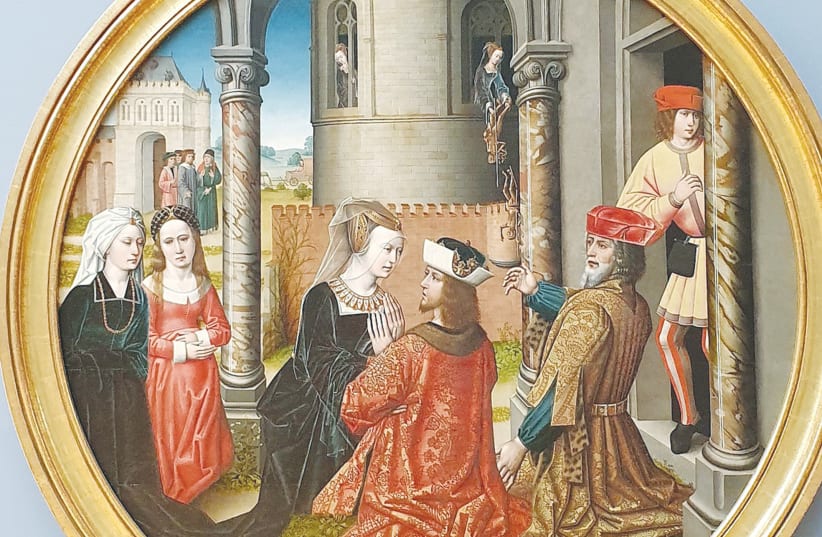The Torah says nothing more about Asenath. She was the daughter of the chief priest who worshiped the Egyptian Sun god Ra in Heliopolis, seven miles northeast of modern Cairo. Their pairing highlighted Joseph’s power. Their sons would be the ancestors of two tribes of Israel, Ephraim being the most powerful tribe in the Northern Kingdom. That is all. Scripture does not bat an eyelash.
But over the passage of centuries, things change. And a Jewish intellectual in Alexandria who lived sometime between 200 BCE and 200 CE considered the story of Joseph, his pagan wife, and their Israelite children a scandal. He had to address in detail what the Book of Genesis simply accepted as proper. The biblical text exhibited pride in Joseph’s power, ascending from an imprisoned Hebrew slave to the husband of the daughter of a powerful idolatrous religious functionary.
But how, the unnamed composer of the Greek novella Joseph and Asenath asked, could this righteous son of the patriarch Jacob, be wed to an idolater, no less the daughter of a priest of a Sun cult? It was a scandal, one might say, of biblical proportions! How could the grandsons of Potiphera be accepted on equal footing with Jacob’s sons as progenitors of the tribes of Israel? In ancient Israel, society was tribal and the wife automatically adopted the religion of her husband. The children’s identity was inherited from the patriarch.
Yet, by the time Joseph and Asenath was composed, conversion was starting to become formalized. Pagans, particularly Roman aristocrats, found great interest in Judaism and Jewish practice. Not all converted – some were known as “God-fearers” who followed a number of the commandments and attended synagogue on Shabbat and holidays. By the time of the editing of the Mishna by Rabbi Judah HaNasi in 200 CE, the religious identity of the child was based on that of the mother, and the tribal system of Jacob and Joseph was a distant memory. Jew and gentile alike now spoke of “Judaism,” and pagans expressed interest in the faith and ritual of the Jews. No, the Bible’s telling of this story had to be updated to reflect the new reality. But the author of Joseph and Asenath did not think he was innovating but, instead, was bolstering tradition.
HISTORIAN ERICH GRUEN, in his Heritage and Hellenism: The Reinvention of Jewish Tradition (1998) defines Joseph and Asenath as a “novelistic fantasy.” Yet, there is a theological polemic in the novella as well. The author takes the brief Torah text and fiercely embellishes it, “cleaning up” what is embarrassing in the original blunt and brief account. The author in Alexandria paints a portrait of the daughter of the priest who wanted to have nothing to with a Hebrew slave, despite his ascension to viceroy to the Pharaoh. But once she sees him for the first time from the window of her palace, she falls in love, mesmerized by Joseph’s beauty. She begs Joseph to marry her but he rejects the notion of marrying a pagan. Asenath begs but Joseph refuses to budge. The daughter of Potiphera decides she must renounce her idolatry.
“The innumerable gods in the room, made of gold and silver, she also broke into pieces.” Historian Gruen describes “much weeping and wailing ensued as she repented from former heresies, removed all false idols from her home, and fell to fasting and mourning, self-flagellation and humiliation, uttering desperate prayers to her newly found god, seeking forgiveness for past sins and rescue from the fury of spurned divinities.”
That night, an angel of God, through a bizarre ritual involving a honeycomb, formalizes Asenath’s “conversion” (not a conversion according to Jewish law, but a conversion nevertheless). Joseph and Asenath became man and wife. She has renounced her idolatry and converted to Judaism, and this poses no problem for their sons as progenitor of Israelite tribes.
Through the power of the imagination, the author of the novella liberates himself from the literal text of the Torah. His radical embellishment leaves no doubt that Joseph and Asenath’s pairing was “kosher.” Mind you, the Torah does not say any of this, reflecting a tribal society that by the time of Alexandria 2,000 years ago had eroded and the term “Judaism” – not found in the Torah – is defended by the novella’s author.
I say none of this to defend patrilineal descent, adopted a generation ago by the Reform movement. That system was tribal and disappeared long ago. To revive it is a mistake, cutting into the heart of a unified Jewish people. However, Rabbi Abraham Isaac Kook, the great religious-Zionist sage, said the Torah is a mirror – always the same eternal mirror – with a different reflection in each generation. The Torah sees nothing wrong with a Jewish hero marrying the daughter of a pagan priest and giving birth to tribes of Israel.
But Joseph and Asenath are not prisoners of the text that reflected a different reality that would emerge later in Jewish history. That is the genius of Judaism. Aggadah and Midrash – as well as the work of Jews who were Hellenistic intellectuals – liberated the figures and laws of the Torah from being chiseled in stone, calcified and ossified. The rabbis passed down the Torah to be a guide for each new generation. As we approach the holiday of Revelation at Mount Sinai –Shavuot – we must remember that we are receiving the Torah anew in every generation. We must be creative and ingenious in our interpretation of an ancient text that lives on in real time.
The writer is rabbi of Congregation Anshei Sholom in West Palm Beach, Florida.
